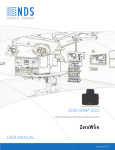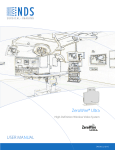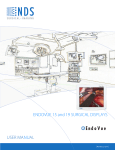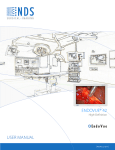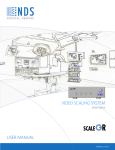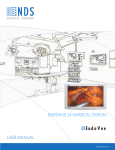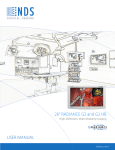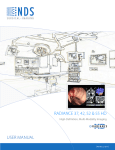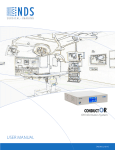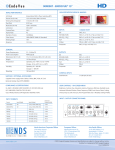Download USER MANUAL ZERO WIRE® DUO
Transcript
ZERO WIRE® DUO High-Definition Wireless Video System User manual [ English] © 2011 NDS Surgical Imaging, LLC. All rights reserved. Information in this document has been carefully checked for accuracy; however, no guarantee is given to the correctness of the contents. This document is subject to change without notice. NDSsi provides this information as reference only. Reference to products from other vendors does not imply any recommendation or endorsement. This document contains proprietary information protected by copyright. No part of this manual may be reproduced by any mechanical, electronic, or other means, in any form, without prior written permission of NDSsi. NDS Surgical Imaging, NDSsi, Radiance, EndoVue, ConductOR, SmartSync and ZeroWire are either registered or unregistered trademarks of NDS Surgical Imaging. All other trademarks are the property of their respective owners. Table of Contents Tab 1 Safety Considerations-------------------------------------------------------------------------------- ii Recycling ------------------------------------------------------------------------------------------------ ii Declarations of Conformity ------------------------------------------------------------------------iii Legal Statement ---------------------------------------------------------------------------------------iii Tab 2 About This Manual------------------------------------------------------------------------------------ 1 Indications for Use ------------------------------------------------------------------------------------ 1 Overview------------------------------------------------------------------------------------------------- 1 Tab 3 Connector Panels-------------------------------------------------------------------------------------- 2 Installation ---------------------------------------------------------------------------------------------- 3 Power Options ----------------------------------------------------------------------------------------- 6 Wiring Diagrams--------------------------------------------------------------------------------------- 7 Setup------------------------------------------------------------------------------------------------------ 8 Typical Installation ------------------------------------------------------------------------------------ 9 All Channels In Use Indication--------------------------------------------------------------------- 9 Performance -------------------------------------------------------------------------------------------- 9 Multi System Installation-------------------------------------------------------------------------- 10 Multi Room Performance ------------------------------------------------------------------------- 10 Advanced Features --------------------------------------------------------------------------------- 11 Tab 4 Troubleshooting ------------------------------------------------------------------------------------ 12 Tab 5 Drawings and Dimensions ----------------------------------------------------------------------- 13 Tab 6 Specifications ---------------------------------------------------------------------------------------- 14 Supported Video Modes ------------------------------------------------------------------------- 15 Cleaning Instructions ------------------------------------------------------------------------------ 15 Optional Accessories ------------------------------------------------------------------------------ 16 Optional Accessory Kits --------------------------------------------------------------------------- 16 Tab 7 Electromagnetic Compatibility------------------------------------------------------------------ 17 Contact---------------------------------------------------------------------------------------------- Back i 1 CAUTION This symbol alerts the user that important literature concerning the operation of this unit has been included. Therefore, it should be read carefully in order to avoid potential problems. This symbol warns user that un-insulated voltage within the unit may have sufficient magnitude to cause electrical shock. Therefore, it is dangerous to make contact with any part inside the unit. To reduce the risk of electric shock, DO NOT remove cover (or back). There are no user serviceable parts inside. If you experience problems with this device, please contact your supplier. To prevent fire or shock hazards, do not expose this unit to rain or moisture. Also, do not use this unit's polarized plug with an extension cord receptacle or other outlets unless the prongs can be fully inserted. The device is designed to meet the medical safety requirements for a patient vicinity device. This device may not be used in connection with life support equipment. Safety Compliance: This device is T.U.V. approved WITH RESPECT TO ELECTRIC SHOCK, FIRE AND MECHANICAL HAZARDS ONLY IN ACCORDANCE WITH UL 60601-1/CAN/CSA C22.2 NO. 601.1. Safety Compliance: This device meets the requirements of EN-60601-1 so as to conform to the Medical Device Directive 93/42/EEC and 2007/47/EC (general safety information). FCC Identification: UEZTZM7201 0673 Radio Approval: This device meets the requirements of EN 302 065 V1.2.1 and conforms to Radio and Telecommunications Terminal Equipment (R&TTE) Directive 1999/5/EC. This device complies to the above standards only when used with the supplied medical grade power supply. Standard Power Supply: 24 Volt: Ault MW172KB2400F02 or Ault MW172KB2400B02 The device should be powered from a center tapped circuit when used in the US at voltages over 120 volts. This product is intended for continuous operation. Recycling: Follow local governing ordinances and recycling plans regarding the recycling or disposal of this equipment , or contact the Electronic Industries Alliance (www.eiae.org) ii Declarations of Conformity FCC and Council Directives of European Standards: This device complies with Part 15 of FCC rules and 93/42/EEC and 2007/47/EC of the Council Directives of European Standards. Operation is subject to the following two conditions: (1) This device may not cause harmful interference, and (2) this device must accept any interference received, including interference that may cause undesirable results. 1. Use the attached specified cables with the device so as not to interfere with radio and television reception. Use of other cable and adapters may cause interference with other electronic equipment. 2. This equipment has been tested and found to comply with the limits pursuant to FCC part 15 and CISPR 11. This equipment generates, uses and can radiate radio frequency energy and, if not installed and used in accordance with the instructions, may cause harmful interference to radio communications. IEC: This equipment has been tested and found to comply with the limits for medical devices to the IEC 60601-1-2. These limits are designed to provide reasonable protection against harmful interference in a typical medical installation. This equipment generates, uses and can radiate radio frequency energy and, if not installed and used in accordance with the instructions, may cause harmful interference to other devices in the vicinity. FCC, Council Directives of European Standards and IEC: There is no guarantee that interference will not occur in a particular installation. If this equipment does cause harmful interference to radio or television reception, which can be determined by turning the equipment off and on, the user is encouraged to try to correct the interference by one or more of the following measures: • Reorient or relocate the transmitter and / or the receiver. • Increase the separation between the equipment and receiver. • Connect the equipment into an outlet on a circuit different from that to which the receiver is connected. • Consult your dealer or an experienced radio/TV technician for help. Accessory equipment connected to this device must be certified according to the respective IEC Standards, i.e. IEC 60950-1, for data processing equipment and IEC 60601-1 for medical equipment. Furthermore, all configurations shall comply with the system standard, IEC 60601-1-1. Anyone who connects additional equipment to the signal input part or signal output part configures a medical system, and is therefore responsible that the system complies with the requirements of system standard IEC 60601-1-1. Whoever is responsible for securing the device to a system needs to insure that the mounting equipment used with this device complies to IEC standard 60601-1. If in doubt, consult with your vendor’s technical service department. Legal Statement NDS sells its products through other medical device manufacturers, distributors and resellers and therefore, purchasers of this NDS product should consult with the entity through which this product was originally purchased regarding the terms of any applicable product warranties provided by such entity, if any. NDS neither assumes nor authorizes any person to assume for it any other liabilities in conjunction with and/or related to the sale and/or use of its products. To ensure proper use, handling and care of NDS products, customers should consult the product specific literature, instruction manual, and/or labeling included with the product or otherwise available. Customers are cautioned that system configuration, software, the application, customer data and operator control of the system, among other factors, affect the product’s performance. While NDS products are considered to be compatible with many systems, specific functional implementation by customers may vary. Therefore, suitability of a product for a specific purpose or application must be determined by the consumer and is not warranted by NDS. NDS SPECIFICALLY DISCLAIMS ALL WARRANTIES OF ANY KIND, WHETHER EXPRESS, IMPLIED AND/OR STATUTORY, INCLUDING, BUT NOT LIMITED TO WARRANTIES OF MERCHANTABILITY, FITNESS AND/OR OF SUITABILITY FOR A PARTICULAR PURPOSE, AND NON-INFRINGEMENT WITH RESPECT TO ALL NDS PRODUCTS OR SERVICES. ANY AND ALL OTHER WARRANTIES, REPRESENTATIONS AND/OR GUARANTEES, OF ANY TYPE, NATURE OR EXTENT, BE IT IMPLIED, EXPRESS AND/OR WHETHER ARISING UNDER OR AS A RESULT OF ANY STATUTE, LAW, COMMERCIAL USAGE, CUSTOM, TRADE OR OTHERWISE, ARE HEREBY EXPRESSLY EXCLUDED AND DISCLAIMED. NDS, its suppliers and/or distributors are not liable, directly or by way of indemnity for any special, incidental, consequential, punitive, exemplary or indirect damages, including but not limited to alleged damages for delayed shipment, non-delivery, product failure, product design or production, inability to use such products or services, loss of future business (lost profits), or from any other cause, whatsoever, in connection with or arising from the purchase, sale, lease, rental, installation or use of such NDS products, these terms and conditions, or with respect to any the terms of any agreement which incorporates these terms and conditions. SOME JURISDICTIONS DO NOT ALLOW EXCLUSIONS AND DISCLAIMERS OF CERTAIN WARRANTIES OR LIMITATIONS OF LIABILITY, SO THE LIMITATIONS AND/OR EXCLUSIONS, SET FORTH HEREIN, MAY NOT APPLY. IN THAT EVENT LIABILITY WILL BE LIMITED TO THE GREATEST EXTENT PERMITTED BY LAW IN THE SUBJECT JURISDICTION. The information provided in this document, including all designs and related materials, is the valuable property of NDS and / or its licensors and, as appropriate, they reserve all patent, copyright, and other proprietary rights to this document, including all design, manufacturing reproduction, use, and sales rights thereto, except to the extent said rights are expressly granted to others. iii About This Manual This manual is designed to assist the user with installation, setup and operation of the NDS ZeroWire® Duo HD wireless video system. 2 A blue numbered tab on the side of the page denotes the beginning of a section. The functional descriptions in this manual are representative of: Part Numbers: 90T2014 = Receiver 90T2015 = Transmitter (Input: DVI) 90T2016 = Transmitter (Input: DVI and 3G-SDI) Manual Part Number: 60G0374 Rev F Indication for Use The NDSsi ZeroWire Duo HD Wireless Video System is a paired transmitter and receiver, intended for delivery of video signals over a radio-frequency link to a video display during endoscopic and general surgical procedures. The ZeroWire HD Wireless Video System is a non-sterile reusable device not intended for use in the sterile field. It is intended for use by qualified physicians having complete knowledge of these surgical procedures. Contraindications: 1. These units are non-sterile reusable devices and are not intended for use within a sterile field. 2. This equipment may not be used in the presence of flammable anesthetics mixture with air, oxygen or nitrous oxide. For mission critical applications, a replacement DVI cable and a BNC terminated coaxial cable shall be immediately available. Overview The ZeroWire Duo transmitter and receiver pair allows wireless delivery of video signals from the DVI or HD-SDI output of an endoscopic camera processor or other video source to the DVI input of a video display. It operates as an unlicensed ultra-wideband (UWB) wireless system in compliance with FCC (Part 15) rules governing UWB. The system is composed of a transmitter (Tx) and a receiver (Rx) pair. The Tx unit is designed to be mounted on the rear top edge of a display on a surgical cart, or on the cart itself. The transmitter may obtain its input video signal from either an endoscopic camera processor or the display’s re-drive output. The Tx unit is powered from the provided 24 VDC power supply (“wall-wart”) or through the optional ‘Y’ adapter cable*. The ‘Y’ adapter cable is described on page 6. The Rx unit is designed to be mounted on the rear top edge of a display, it may also be mounted on a cart, and is powered from the provided 24 VDC power supply (“wall-wart”) or through the optional ‘Y’ adapter cable*. The ‘Y’ adapter cable is described on page 6. A typical installation is shown on page 9. *Note: The ‘Y’ adapter cable is for use with NDS 19”, 24”, 26” and 32” Radiance and 24” EndoVue displays only. 1 Connector Panels ZeroWire Transmitter (Tx) ZeroWire Receiver (Rx) 3 3G– SDI input (90T2016 only) DVI input DVI output Power connector Tx & Rx Common Connectors The USB port is used for installing updates to the Tx or Rx firmware. It is not a general purpose I/O port The BOND button allows the bonding of a transmitter to a receiver. 2 Installation Mounting Options: 24” and 26” Radiance Displays : Each step bracket is stamped with a part number (P/N). For Radiance 24” and 26” displays, select step bracket P/N 20C0660. Replace the left hand mounting screws with 2 of the provided mounting screws, do not tighten them. Remove the two right hand screws from the VESA mount . With the side stamped FRONT facing the front of the display, slide the step bracket between the VESA mount and the back of the display until notches labeled for the display you are working with fit over the two left hand screws. Replace the right hand screws with the screws provided and tighten all screws. With the black surface of a ZeroWire Rx or Tx module facing the front of the display, align the slot on the bottom of the module with the top of the bracket and push the module down on the bracket until the module seats. This side faces the front of the display. Figure 1. Typical ZeroWire installation on a NDS Radiance 26. 19” and 23” Radiance and 24” EndoVue Display: Each step bracket is stamped with a part number (P/N). For Radiance 19” and 23” and EndoVue 24” displays, select step bracket P/N 20C0683. Replace the left hand mounting screws with 2 of the provided mounting screws, do not tighten them. Remove the two right hand screws from the VESA mount . With the side stamped FRONT facing the front of the display, slide the step bracket between the VESA mount and the back of the display until notches labeled for the display you are working with fit over the two left hand screws. Replace the right hand screws with the screws provided and tighten all screws. With the black surface of a ZeroWire Rx or Tx module facing the front of the display, align the slot on the bottom of the module with the top of the bracket and push the module down on the bracket until the module seats. The completed assembly will look like Figure 1 above. This side faces the front of the display. 3 32” and 37” Radiance Displays: Select ‘T’ bracket (P/N 20C0684). Lay the display face down on a clean surface. Center the ‘T’ bracket on the top edge of the display and remove the 2 screws that are aligned with the holes in the bracket. Insert the provided screws through the bracket and case back. Tighten both screws. With the black surface of a ZeroWire Rx or Tx module facing the front of the display, align the slot on the bottom of the module with the top of the bracket and push the module down on the bracket until the module seats. Typical ZeroWire installation on a NDS Radiance 37. 42”, 52” and 55” Radiance Displays: Select ‘T’ bracket (P/N 20C0668). Lay the display face down on a clean surface. Center the ‘T’ bracket on the top edge of the display and remove the 2 screws that are aligned with the holes in the bracket. Insert the provided screws through the bracket and case back. Tighten both screws. With the black surface of a ZeroWire Rx or Tx module facing the front of the display, align the slot on the bottom of the module with the top of the bracket and push the module down on the bracket until the module seats. Typical ZeroWire installation on a NDS Radiance 42. 4 Desktop: With the side stamped FRONT and the black surface of a ZeroWire Rx or Tx module facing you, insert the desktop mount into the slot in the bottom of the module and push downwards on the mount until the module seats. Install with this side facing the black side of the Rx or Tx. 5 Power Options ZeroWire transmitters and receivers may be powered from the provided power supply (pictured below), or when used with an NDS display they may be powered from the display’s power supply via the supplied ‘Y’ adapter cable. ‘Y’ adapter cables, shown below, are available for Radiance 19”, 24”, 26” and 32” displays and Endovue 24” display. ‘Y’ adapter cables are not available for 37”, 42”, 52” or 55” Radiance displays. ‘Y’ adapter cable (35X0096) for 19”, 24” and 26” Radiance Displays and 24” EndoVue Display ‘Y’ adapter cable (35X0097) for 32” Radiance Display When using the included power supply, select and install the plug adapter that matches the wall socket in your OR. Provided power supply or J3 of the ‘Y’ adapter connects here. 6 Wiring Diagrams Display Mounted Tx Wiring Diagram Display Mounted Rx Wiring diagram 7 Setup Bonding the Transmitter (Tx) and Receiver (Rx) Before the ZeroWire wireless system can be put into service , the Tx and Rx pair must be bonded. Connect an included power supply or a ‘Y’ Adapter cable to a Tx and an Rx unit. See page 6 for Power Connector location and ‘Y’ Adapter cable information. The status indicator LED of each unit should be yellow and blinking slowly. If the LED’s are steady yellow then the Tx and Rx pair is already bonded, continue at the Passing Video section below. Bonding Procedure: 1. If the Tx’s LED is alternating between blue and yellow, then all ZeroWire channels are in use. See page 9 for details. 2. Press and hold the “bond” button (see Figure 1 for location) on the Tx unit until its LED begins flashing rapidly, then release. Next press and hold the “bond” button (see Figure 1 for location) on the Rx unit until its LED begins flashing rapidly, then release. 3. When the bonding process is complete each unit’s LED will be steady yellow. Figure 1 Tx Rx Bonding Button Press here Passing Video: With the bonding completed, connect a DVI or SDI video source to the Tx unit and a display to the Rx unit via its DVI output (Figure 2). The indicator LED’s should turn blue and the source image should appear on the display. This completes the basic setup. Figure 2 Endoscope Processor Tx Rx Note: The transmitter and receiver are not limited to line-of-sight operation, i.e., the pair will operate reliably despite the presence of intervening obstacles. However, neither unit should be completely surrounded by metallic objects. 8 Typical Installation Transmitter Receiver Display hardwired to image source (processor). NDSsi recommends ZeroWire for primary and secondary displays. However, for patient safety a display that is cable connected to the video source shall be immediately available whenever a surgical procedure is in progress. All Channels In Use Indication Tx Indication: 1. When all channels are in use and a new ZeroWire pair or a new Tx is turned on: The LED on the Tx will alternate between blue and yellow continuously or until it finds a free channel. If a free channel is found, then the LED will behave as described in Bonding Procedure on page 8. 2. When all channels are in use and the bonding button is pressed on a new Tx. The LED on the Tx blinks fast yellow, indicating that the device is attempting to bond. If no channel is found, then the LED blinks alternately until the bonding times out. If an available channel is found, then the LED will behave as described in Bonding Procedure on page 8. Rx Indication: Rx is not aware that all channels are in use. Performance Performance: ZeroWire HD Wireless Video System products are intended and optimized for use in a surgical operating room (OR). Use outside of an OR environment is not recommended. The following steps will help you to achieve optimal performance of the ZeroWire system: 1. Mount both components at least 1.5 meters (5 feet ) from the floor. 2. Ideally, both the transmitter and receiver should be at the same height. 3. For a reliable video link, the distance between transmitter and receiver should be 10 meters (30 feet) or less . 4. The black surfaces of the transmitter and receiver should be vertical, facing each other and be visible to each other in free air space. We do not recommend orienting the modules horizontally. 5. For non line of sight applications, we recommend that the Tx and Rx be located no more than 6 feet (2 meters) from the walls of the OR. 9 Multi System Installation Multiple Systems: When two or three systems are installed in a given OR if the Tx and Rx units have not been bonded apply power to one Tx and one Rx then follow the Bonding Procedure described on page 8. Turn second Tx and Rx pair on and repeat the Bonding Procedure. Turn on the third pair and repeat the Bonding Procedure. Tx and Rx pairs must be bonded one pair at a time. We recommend that bonded pairs be labeled to facilitate installation and troubleshooting. ZeroWire transmitters should be separated by at least 0.5 meters (20 inches). ZeroWire transmitters (Tx) or receivers (Rx) should not be installed in metal cabinets or surrounded by metallic objects, as this will prevent the Tx from communicating with the Rx. Note: 1. ZeroWire has three channels, therefore no more than three Tx / Rx pairs can be installed in an OR. 2. To re-use a given frequency channel, NDS recommends a minimum distance of 75 feet (23 m) between systems. For additional information refer to Advanced Features on page 11. Multi Room Performance Same Channel Reuse: A given channel may be used in multiple OR’s provided that the separation between systems is great enough that the Rx of one system does not detect the Tx of another system (crosstalk). The likelihood of crosstalk occurring is greatly reduced or eliminated by obstacles such as: 1. A wall separating the rooms. 2. Materials the wall is constructed from and its thickness. 3. Finish applied to the wall. 4. Metallic pipes routed inside the wall. Operation of a given ZeroWire system for room to room communications is not recommended and not supported. 10 Advanced Features Overview: The Update Channel / Power Utility* software allows the user to configure some of ZeroWire transmitter and receiver parameters. The parameter settings are discussed in the following paragraphs. Channel Selection (Tx only): This feature allows the user to “lock” a Tx to one of the 3 available channels or allow Auto Channel selection. Auto Channel is the default. ATPC Selection (Tx & Rx): ATPC increases or decreases a Tx’s power when OR equipment is moved and the distance between the Tx and the Rx is changed. If ATPC is turned off the Tx’s power is set to maximum. The parameter may be turned ON or OFF to enable or disable ATPC. The default is ON. Deep Sleep Selection (Tx only): When a surgical procedure is completed and the Rx turned off for a period of 3 minutes or longer, the Tx goes into Deep Sleep Mode. This frees the Tx’s frequency channel for use by another ZeroWire system. Recovery from deep sleep requires momentarily pressing the Tx’s Bond button. See Bonding Procedure on page 8. Deep Sleep prevents unused ZeroWire transmitters from unnecessarily occupying a frequency channel. The parameter may be turned ON or OFF to enable or disable Deep Sleep. The default is ON. * Note: The Update Channel / Power Utility software and its usage instructions are on the CD included in the ZeroWire shipping box. 11 Troubleshooting Problem Possible Causes Indicator LED is not on. Loose Power Connector: Verify that the power source connector is fully inserted into the unit’s power connector. 'Y' Cable: If you are using the ‘Y’ cable to supply power to the unit, confirm that it is connected to a power supply and that the power supply is energized. Stand Alone Power Supply: If the stand alone power supply is being used confirm that it is fully inserted into the wall socket. Wall Socket: Some wall sockets have on / off switches built in. If the socket you are using has a built in switch, check that is in the on position. Additional Information: See Power Options on page 6. No video, intermittent This problem has a number of causes. The most likely of which are shown in the video or poor quality table below. video displayed. Cause Remedial Action Tx and RX are spaced more than 10 Reduce the spacing between the Tx and Rx to 10 meters (30 feet) or meters (30 feet) apart. less. See Tx to Rx Range specification on page 13. Tx and Rx are not aligned properly See Performance section on page 9. DVI or SDI (Tx only) connections Confirm that the cables are properly connected. Unsupported video mode Verify that the applied video mode is supported. See the Supported Video Modes table on page 14. DVI or SDI (Tx only) cables Replace the cables one at a time and check the video display. If the video signal displays properly after a cable is replaced, discard the cable you just replaced. Crosstalk See page 10 LED Indicators LED State Description Yellow and blinking slowly The unit is not bonded. See Bonding Procedure on page 8. Yellow and flashing rapidly Unit is attempting to bond. See Bonding Procedure on page 8. Yellow and steady Unit is bonded and communicating with another unit. See page 8. Blue and steady The unit is sending (Tx) or receiving (Rx) video data. Blue and blinking slowly The source is sending an encrypted signal. Encrypted signals are copyrighted and may not be re-transmitted. Alternating Blue and Yellow All channels are in use. This state applies to transmitters only. See page 9. 12 4 Drawings and Dimensions Both Units 5 Transmitter Receiver 13 Specifications Wireless Signal Type Ultra Wideband (UWB) Frequency Band 3.1 to 4.8 GHz RF Power Out (maximum) -41.25 dBm / MHz Tx to Rx Range (Line of sight not required) Up to 30 ft (9.14m)1 Data Rate 53.3 to 480 Mbps System Latency < 1 frame Compression Technology H.264 Super Low Latency Technology™ 2 Hardware Encryption 128 bit AES Video Inputs (Transmitter) DVI, 3G SDI , HD-SDI and SDI Video Outputs (Receiver) DVI Power Consumption DC Power Supply 6 14 Watts (Max) 100-240VAC 50/60Hz input 24V @ .75A DC (18 watts) output Physical Dimensions 7.04” x 7.40” x 1.43” (178.9mm x187.9mm x 36.4mm) ZeroWire Weight (Tx or Rx) excluding base 1.4 lbs (0.64 Kg) Mounting Base Weight 0.8 lbs (0.36 Kg) Operating Temperature 32° to 104° F (0° to 40° C) Operating Humidity 10% to 80% RH, non-condensing Storage Temperature 32° to 122° F (0° to 50° C) Storage Humidity < 70% RH (non-condensing) 1. The effective range may vary depending upon the environment in which the product is operating. Follow the product’s Setup section to achieve optimum performance and range. 2. Super Low Latency Technology is a trademark of Cavium Networks, Inc. 14 Supported Video Modes Name Horiz Active Horiz Total Vert Active Vert Total 1080p/60 1080p/50 1920 1920 2200 2640 1080 1080 1125 1125 1080p/30 1080p/25 1920 1920 2200 2640 1080 1080 1125 1125 1080i/60 1920 2200 1080 562 1080i/50 1920 2640 1080 562 1280x1024/60 1280 1688 1024 1066 1280x960/60 1280 1576 960 1000 1024x768/60 720p/60 1024 1280 1344 1650 768 720 806 750 720p/50 1280 1980 720 750 480p/60 576p/50 VGA(SMT0660) SVGA(DMT0860) 720 720 640 800 870 864 800 1056 480 576 480 600 525 625 525 628 XGA(DMT1060) 1024 1344 768 806 SXGA(DMT1260G) 1280 1688 1024 1066 NTSC 720 858 480 262 PAL 720 864 576 312 Custom Mode 1440 1904 900 932 Custom Mode 1024 1124 1024 1068 Custom Mode 1024 1152 1024 1250 Cleaning Instructions We recommend turning the device off prior to cleaning. Follow your organization’s protocol for the handling of blood and body fluids. Clean the device with a diluted mixture of mild detergent and water. Use a soft towel or swab. Use of certain cleaning agents may cause degradation to the plastic enclosure and labels of the product. The plastic is ABS. Consult the cleanser manufacturer to see if agent used for cleaning is compatible with ABS. Do not allow liquid to enter the device. 15 Optional Accessories Part Number Description 20C0660 VESA Mount Bracket for 24" and 26" Radiance Displays 20C0683 VESA Mount Bracket for 19" and 23" Radiance Displays and 24" EndoVue Display 20C0684 Top Mount Bracket for Radiance 32" and 37" Radiance Displays 20C0668 Top Mount Bracket for Radiance 42", 52" and 55" Radiance Displays 26B0099 Spare Table Stands 30B0038 Spare Power Supply 35X0096 'Y' Adapter Cable for 19", 24" and 26" Radiance Displays and 24" EndoVue Display 35X0097 'Y' Adapter Cable for 32" Radiance Display 35D0073 6ft DVI Cable 35D0081 6ft 3G-SDI Cable 35D0091 Spare 3ft DVI Cable 35D0092 Spare 2ft DVI Cable 35D0093 Spare 3ft SDI Cable 60A0374 Printed ZeroWire Users Manual See Page 3 3 4 4 5 6 6 6 Contact NDS Sales for price and availability. Contact information is on the back cover. Optional Accessory Kits Part Number Description and Contents 90Z0118 Packaged ZeroWire Accessory Kit for 24" and 26" NDS displays 20C0660 VESA Mounting Brackets 35X0096 'Y' Adapter Cable 3ft (0.91m) DVI Cable 3ft (0.91m) SDI Cable Qty 2 2 2 1 90Z0119 Packaged ZeroWire Accessory Kit for 32" and 37" NDS displays 20C0684 Top Mount Bracket for Radiance 32" and 37" Radiance Displays 35X0097 'Y' Adapter Cable 3ft (0.91m) DVI Cable 3ft (0.91m) SDI Cable Qty 2 2 2 1 90Z0120 Packaged ZeroWire Accessory Kit for 42", 52" and 55" NDS displays 20C0668 Top Mount Bracket for Radiance 42", 52" and 55" Radiance Displays 3ft (0.91m) DVI Cable 3ft (0.91m) SDI Cable Qty 2 2 1 Packaged ZeroWire Accessory Kit for 19" and 23" Radiance and 24" EndoVue displays 20C0683 VESA Mounting Brackets 35X0096 'Y' Adapter Cable 3ft (0.91m) DVI Cable 3ft (0.91m) SDI Cable Qty 2 2 2 1 90Z0121 Contact NDS Sales for price and availability. Contact information is on the back cover. 16 Electromagnetic Compatibility ZeroWire has been tested in an OR environment and did not interfere with electrosurgical, ultrasound, XRay, medical displays and life monitoring equipment. Neither did the aforementioned equipment interfere with ZeroWire. Additionally, since ZeroWire operates in 3.1 – 4.8 GHz, typically wireless LAN and mobile phones will not cause interference as they operate outside the ZeroWire frequency range. However, the presence of a source of interference within ZeroWire frequency range may result in intermittent operation and reduced image quality or the link could go down while the interference exists. Prior to any procedure in the OR, it is required that any such equipment be turned off and verify that the system operates as expected. If any anomalous behavior is observed, it must be corrected prior to using the system in any surgical procedures. ZeroWire transmitters should be separated by at least 0.5 meters (20 inches). ZeroWire transmitters (Tx) or receivers (Rx) should not be installed in metal cabinets or surrounded by metallic objects, as this will prevent the Tx from communicating with the Rx. During installation the ZeroWire link video quality should be tested with the transmitter at different orientation angles and mounting locations. This is required if the placement of the ZeroWire components deviates from the recommended guidelines on page 9 of this manual or when they must be adjacent to or stacked below other equipment. We recommend that the system be thoroughly tested prior to using it in any surgical procedures. 7 Do not use power supplies or cable accessories with the ZeroWire other than those specified in this manual. Excessive leakage currents, elevated electromagnetic emissions, or insufficient interference immunity may occur. All medical electronic devices, including ZeroWire, must conform to the requirements of IEC 60601-1-2. Precautions, adherences to the EMC guideline information provided in this manual and verification of all medical devices in simultaneous operation are required to ensure the electromagnetic compatibility and co-existence of all other medical devices prior to a surgical procedure. The EMC tables on pages 17 and 18 are provided for your reference. 17 EMC Tables 200 - 202 Cable Type Power Video Video Video Video Emissions test RF emissions CISPR 11 Table 200 Description Hospital Grade UL/CSA/TUV Approved Male to Male SXGA S-Video HD15(M) - 5 BNC(F) DVI-D Single Link Length (m) 3.0 3.0 3.7 0.3 3.0 Shielded No Yes Yes Yes Yes Ferrite No Yes No No Yes Table 201 Guidance and manufacturer’s declaration – electromagnetic emissions Compliance Electromagnetic environment - guidance Group 1 This device uses RF energy only for its internal function. Therefore, its RF emissions are very low and are not likely to cause interference in nearby electronic equipment. RF emissions CISPR 11 Class A Harmonic emissions IEC 61000-3-2 Voltage fluctuations/flicker emissions IEC 61000-3-3 Class A This device is suitable for use in all establishments other than domestic and those directly connected to the public low voltage power supply network that supplies buildings used for domestic purposes. Complies Table 202 Guidance and manufacturer’s declaration – electromagnetic immunity Immunity test EN IEC 60601 test level Compliance level Electrostatic Discharge (ESD) ± 4 kV contact Complies IEC 61000-4-2 ± 8 kV air ± 4 kV contact ± 8 kV air Electrical fast ± 2 kV for power supply lines Complies transient/burst ± 1 kV for input/output lines ± 2 kV for power supply IEC 61000-4-4 lines ± 1 kV for input/output lines Surge ± 1 kV differential mode Complies IEC 61000-4-5 ± 2 kV common mode ± 1 kV differential mode ± 2 kV common mode Voltage dips, short <5% UT * Complies <5% UT* interruptions and voltage (>95% dip in UT) variations on power supply for 0.5 cycle (>95% dip in UT) input lines for 0.5 cycle IEC 61000-4-11 40% UT Complies 40% UT (60% dip in UT) for 5 cycles (60% dip in UT) for 5 cycles 70% UT Complies 70% UT (30% dip in UT) for 25 cycles (30% dip in UT) for 25 cycles <5% UT Complies <5% UT (>95% dip in UT) for 5 sec (>95% dip in UT) for 5 sec Power frequency 3A/m Complies (50/60 Hz) 3A/m magnetic field IEC 61000-4-8 Complies * Note: UT is the a.c. mains voltage prior to application of the test level. 18 EMC Tables 204 and 206 Immunity test Table 204 Guidance and manufacturer’s declaration – electromagnetic immunity – for equipment and systems that are not life-supporting IEC 60601 test level Compliance level Electromagnetic environment - guidance Portable and mobile RF communications equipment should be used no closer to any part of the device, including cables, than the recommended separation distance calculated from the equation applicable to the frequency of the transmitter. Recommended separation distance: [ 3] P 150 kHz to < 80 MHz [ 3] P 80 MHz to < 800 MHz [ 3] P 800 MHz to 2.5 GHz Conducted RF IEC 61000-4-6 3 Vrms 150 kHz to < 80 MHz 3 volts d = 3.5 Radiated RF IEC 61000-4-3 3 V/m 80 MHz to 2.5 GHz 3 V/m d = 3.5 d = 7 Where P is the maximum output power rating of the transmitter in watts [W] according to the transmitter manufacturer and d is the recommended separation in meters [m]. Field strengths from fixed RF transmitters, as determined by an electromagnetic site surveya, should be less than the compliance level in each frequency rangeb. Interference may occur in the vicinity of equipment marked with the following symbol: Note: These guidelines may not apply in all situations. Electromagnetic propagation is affected by absorption and reflection by structures, objects and people. a Field strengths from fixed transmitters, such as base stations for radio [cellular/cordless] telephones and land mobile radios, amateur radio, AM and FM radio broadcast and TV broadcast cannot be predicted theoretically with accuracy. To assess the electromagnetic environment due to fixed RF transmitters, an electromagnetic site survey should be considered. If the measured field strength in the location in which the unit is used exceeds the applicable RF compliance level above, the unit should be observed to verify normal operation. If abnormal performance is observed, additional measures may be necessary, such as reorienting or relocating the unit. b Over the frequency range 150 kHz to 80 MHz, field strengths should be less than 3 V/m. Table 206 Recommended separation distances between portable and mobile RF communications equipment and the display. Separation distance d [m] according to frequency of transmitter Rated maximum 150 kHz to < 80 MHz 80 MHz to < 800 MHz 800 MHz to 2.5 GHz output power of ⎡7 ⎤ ⎡ 3 .5 ⎤ ⎡ 3 .5 ⎤ d = ⎢ ⎥ P d =⎢ d =⎢ transmitter ⎥ P ⎥ P ⎣3 ⎦ ⎣ 3 ⎦ ⎣ 3 ⎦ [W] 0.0 0.12 0.12 0.23 0.1 0.38 0.38 0.73 1.0 1.2 1.2 2.3 10.0 3.8 3.8 7.3 100.0 12 12 23 19 Notes Notes Notes Notes Corporate Headquarters 5750 Hellyer Avenue San Jose, CA 95138 S www.ndssi.com 60G0374 Tel: 408 776 0085 E mail: [email protected] Europe Asia Pacific N Takanawa Kaneo Bldg., 6F Asakusabashi 5-Chome, Minato-ku Tokyo 108-0074 Japan Tel: + 81 3 5475 1835 Email: [email protected] E The Netherlands Tel: N Email: [email protected]
































